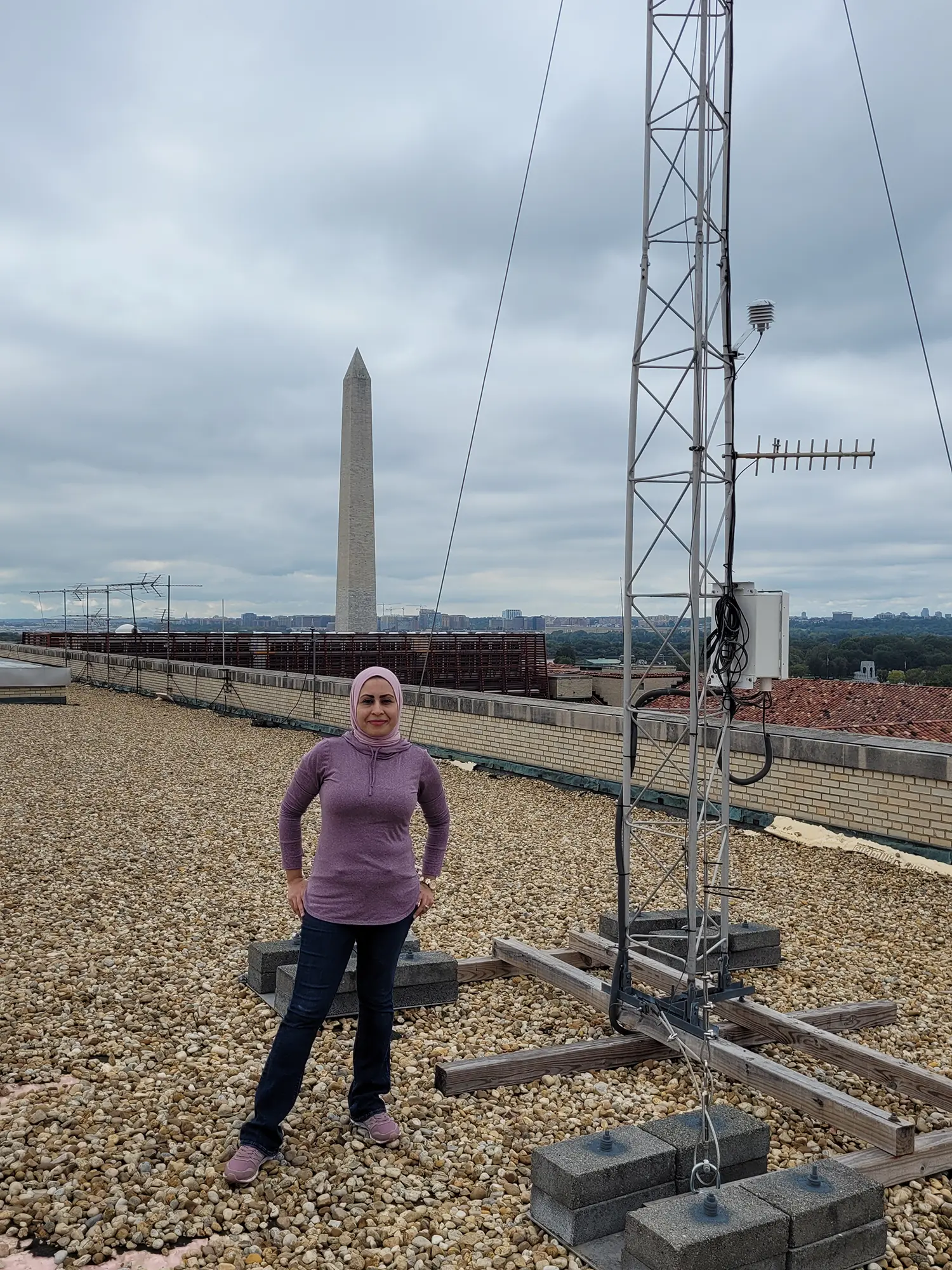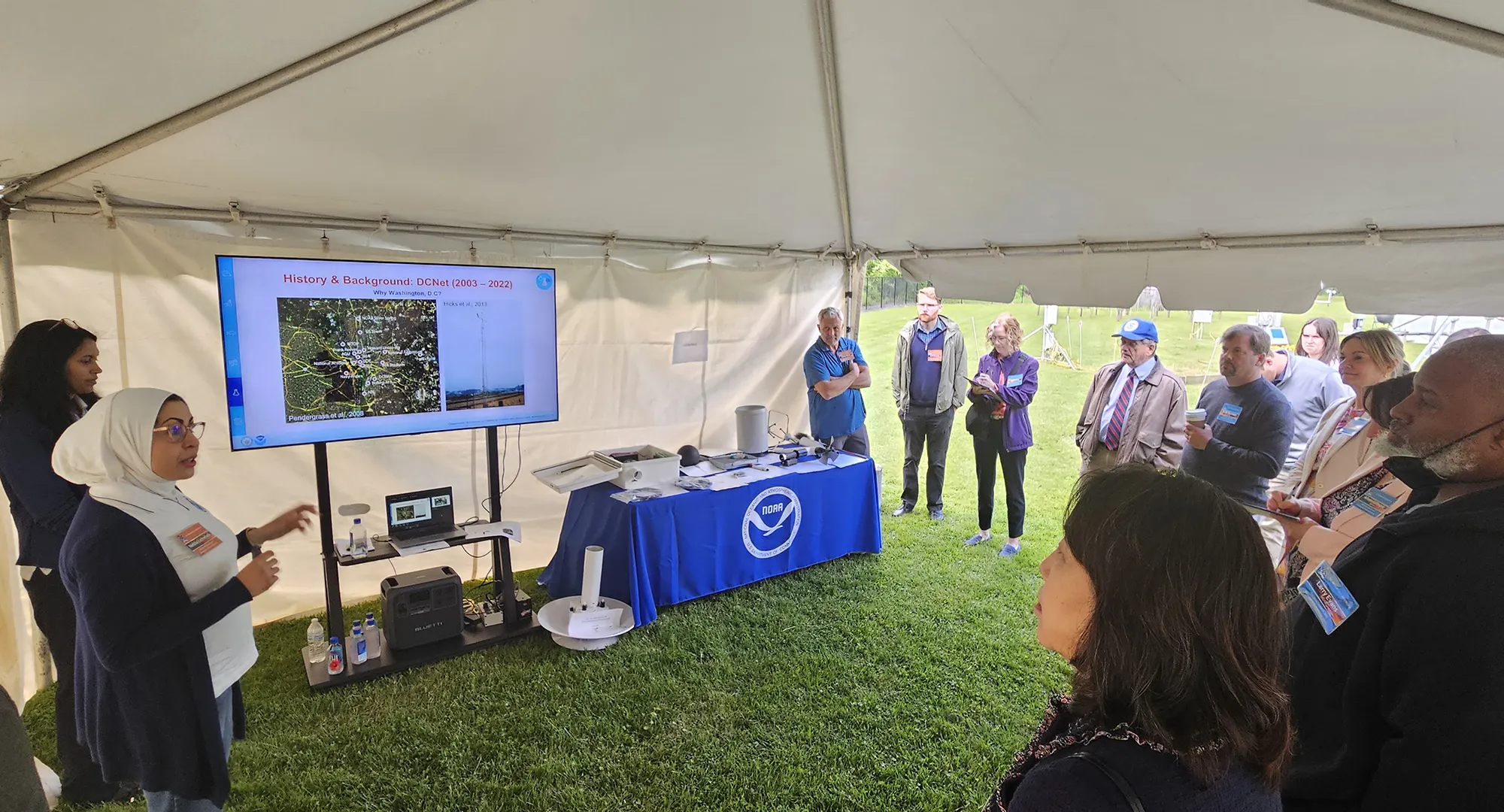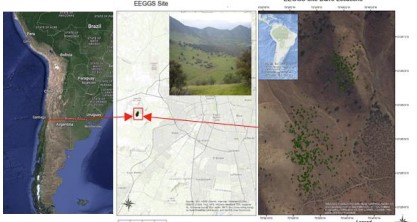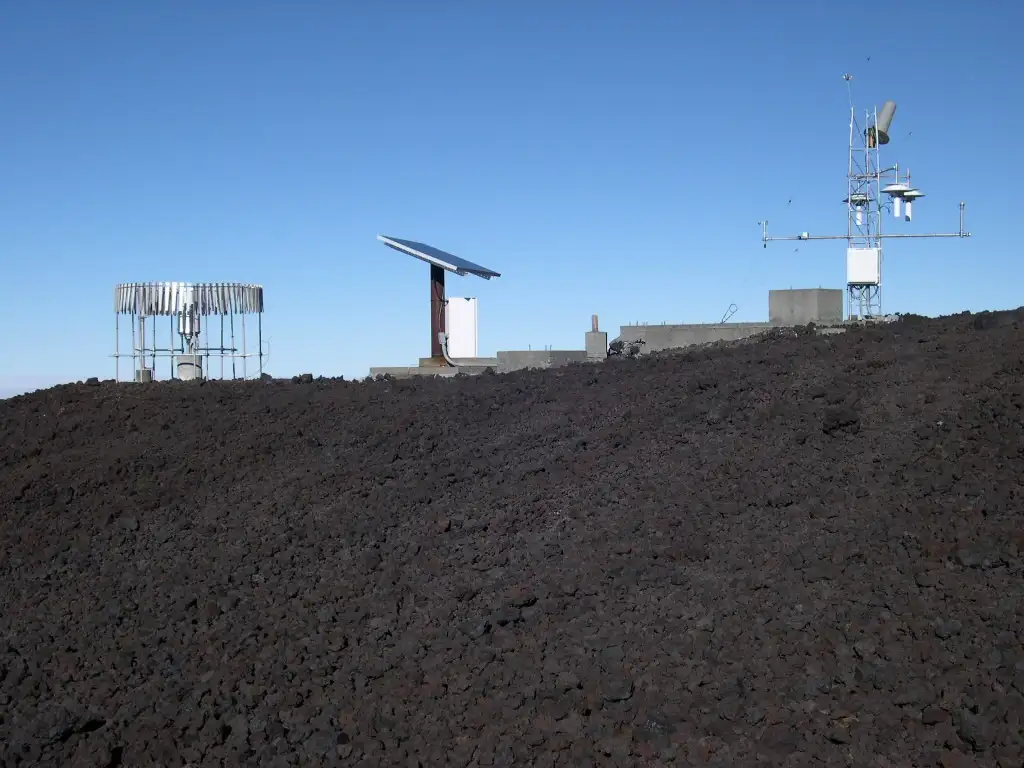
Nebila Lichiheb, Ph.D., checks an UrbanNet station on the Herbert C. Hoover Building in Washington, D.C.
In an era where the intersection of technology and environmental science has become a frontier of innovation, the partnership between ORAU and the National Oceanic and Atmospheric Administration (NOAA) stands as a great example of progress. Together, through NOAA’s Air Resources Laboratory, ORAU and NOAA’s Atmospheric Turbulence and Diffusion Division (ATDD) established and continue to maintain the U.S. Climate Reference Network, which is comprised of long-term climate observation stations across the country. The data this network collects is critical to measuring atmospheric trends, tracking weather and generally monitoring our overall climate, but the information is even more valuable when supplemented with data from additional programs such as the ORAU Directed Research and Development (ODRD) program.
The ODRD program invests in research collaboration between ORAU researchers and university faculty at ORAU consortium member institutions. Simply put, ODRD offers seed money for exploratory research and collaboration between our subject matter experts and ORAU’s university partners. It’s a win-win for all parties.
Take early career scientist and ATDD employee Nebila Lichiheb, Ph.D., for example. She’s starting her proposal for the next ODRD cycle. While winning an ODRD award would benefit Lichiheb and her work, it would also be a tremendous boost for NOAA.
Dr. Lichiheb has already been working with the University of Maryland on improving the atmospheric dispersion forecasts over Washington, D.C. using archived UrbanNet (formerly DCNet) observations.
Specifically, Lichiheb conducts data analysis and numerical simulations to resolve the complexity of the urban ecosystem and improve air quality forecasting.
Since the beginning of 2023, DCNet has been refurbished to better characterize the urban environment and has been renamed UrbanNet to expand to other cities. If awarded, the ODRD funding will give Dr. Lichiheb the opportunity to analyze the upgraded UrbanNet data. She hopes to detect heatwaves and improve modeling capabilities to simulate the dispersion and trajectory of city pollution, which Lichiheb says is more problematic during periods of high temperatures. It’s a capability NOAA already has and if given the opportunity to further develop its application, the potential is for NOAA to offer life-saving information to decision makers during emergencies.
“We want to optimize the use of the unique federal data collected over the greater National Capital Region to study the urban meteorology and refine the estimation of air pollution in this complex terrain,” Lichiheb explained. “I need the University of Maryland’s expertise in adjusting the numerical weather prediction models needed to initialize dispersion models, and they need me and UrbanNet’s data to enhance these models.”

Dr. Lichiheb and her team present research findings at the Air Resources Laboratory open house event.
The mutually beneficial collaboration advances both parties’ interests. “We already have the instrumentations and high-resolution meteorological data, so in this project, I’m bringing the modeling community and the measurement community together,” Lichiheb continued.
How does this project potentially produce life-saving information? NOAA offers a system for computing simple air parcel trajectories, as well as complex transport, dispersion, chemical transformation and deposition simulations. It’s called HYSPLIT, and it was put to good use in November of 2020 when a huge fire broke out at a recycling plant in Houston, Texas. The HYSPLIT Atmospheric Dispersion predictions provided pertinent information to the Houston Office of Emergency Management so they could safely evacuate people in a direction away from the most harmful pollution from the fire.
Arial view of recycling plant fire in Houston, Texas on Nov. 11, 2020. Photo credit: KHOU HYSPLIT Atmospheric Dispersion predictions from Nov. 11, 2020, northeast Houston, Texas, smoke plume.

Lichiheb wants to take HYSPLIT and use it more widely in the event of an incident in urban areas across the United States where the highest air pollution exposure and related health issues occur. She sees the need for this real-time capability.
“When there’s an emergency and you need to evacuate people, it’s further complicated if there’s a dangerous pollutant in the air. Decision-makers need to know when to evacuate and where,” Lichiheb said. “We cannot provide accurate forecasts if we don’t have accurate, real time and continuous measurements. It’s labor intensive and expensive, so that’s why I’m applying for ODRD funding.”

Tim Wilson, Ph.D., soil scientist
Not only does the ODRD program foster complementary research efforts, but it also serves as a catalyst for expanded missions. Two years ago, Lichiheb’s colleague, Tim Wilson, Ph.D., a soil scientist at ATDD, used the experience of NOAA’s research laboratory, ATDD, and the U.S. Climate Reference Network to apply satellite-based observations to rodents in South America and how climate change affects the rodent population (i.e. mapping rodent habitats, tracking population size and distribution, etc., which can impact human health, agriculture, ecosystems, pest management and so on). While it’s not complementary research like Lichiheb’s work, it identified additional uses of how the existing ATDD dataset can be used to validate satellite-based data. The endeavor confirmed the multipurpose nature of data collection and highlighted the opportunity to translate data into other critical disciplines. Could NOAA take its capabilities and collaborate in cross department partnerships with agencies like the EPA, USDA or the U.S. Forestry Service? It’s a worthwhile question to explore. Encouraged by his results from that partnership, Dr. Wilson is in the middle of another ODRD project: Evaluating the use of small Uncrewed Aircraft Systems to advance understanding of micro- and meso-scale weather phenomena at the urban-rural interface.
Visual of study location in Tim Wilson’s, Ph.D., ODRD proposal to study the impact of climate on a rodent native to north Chile.
The partnership between ORAU and NOAA, facilitated through ODRD, exemplifies the remarkable synergy between technological innovation and environmental stewardship. By fostering collaborations that extend beyond traditional research boundaries, ODRD funding not only accelerates NOAA’s mission-critical work but also opens avenues for groundbreaking discoveries that can significantly impact public health and safety. As researchers like Drs. Lichiheb and Wilson ambitiously pursue projects that promise to enhance our understanding and management of environmental challenges, the broader implications of their work underscore the transformative power of strategic investment in science. Through the lens of these collaborations, it becomes evident that the ripple effect of ODRD funding reaches far beyond ORAU, NOAA and the immediate scientific community, heralding a future where informed decision making and proactive management are seamlessly integrated to safeguard our world and its inhabitants.
